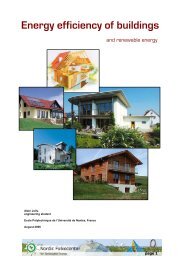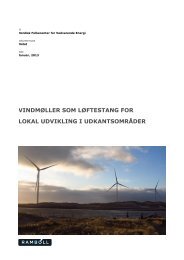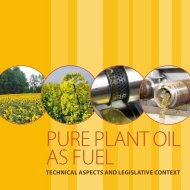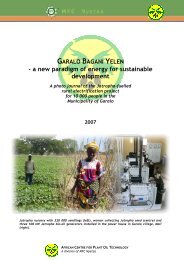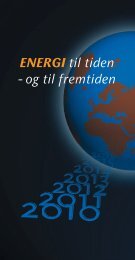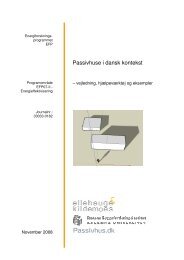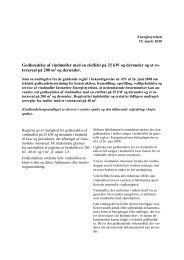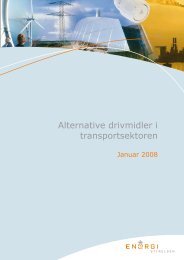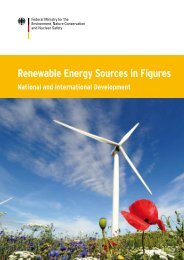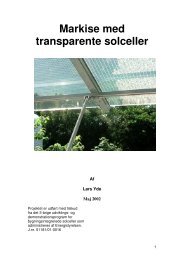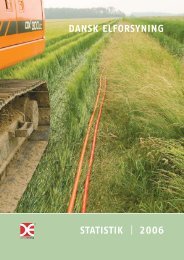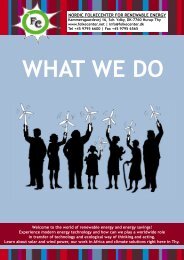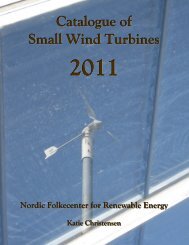Download rapporten som PDF dokument - Nordic Folkecenter for ...
Download rapporten som PDF dokument - Nordic Folkecenter for ...
Download rapporten som PDF dokument - Nordic Folkecenter for ...
Create successful ePaper yourself
Turn your PDF publications into a flip-book with our unique Google optimized e-Paper software.
English summary<br />
Within the framework of the “Village <strong>for</strong> Green Research” at <strong>Folkecenter</strong> <strong>for</strong><br />
Renewable Energy (FC), various <strong>for</strong>ms of green waste water treatment have been<br />
tested since 1988. Today three different plants exist (see figure 2.2.1) which can<br />
work independently of each other, while they are, however, connected to each<br />
other so that they can be used at the same time.<br />
Household waste water from 20 person equivalents (PE, see enclosure C) and from<br />
the about 4000 m 2 buildings is finally led to the root zone plant which is the biggest<br />
plant in the area. The two test plants in the greenhouse make it possible to carry out<br />
several tests and development of plants <strong>for</strong> household waste water treatment<br />
without taking into account if a sufficient efficiency during the tests is obtained so<br />
that the cleaned waste water can be led to the recipient (SkibstedFjord).<br />
In 1988, the first demonstration plant was established as a decentralized solution<br />
model <strong>for</strong> waste water cleaning by utilization of ecological cleaning principles and<br />
a minimum of energy consumption. The composition of the plant has been inspired<br />
by the so-called “Vermont-model”. The plant is based on the utilization of energy<br />
from the sun <strong>for</strong> removal of nutritive salts as e.g. phosphates and nitrates through<br />
bacterial decomposition and absorption in plant tissue. In co-operation with<br />
Botanical Institute, Aarhus University, analysis of the waste water were made<br />
be<strong>for</strong>e, during and after the treatment in the plant. The plant was established in<br />
greenhouse 1 and 2 (see plan, figure 2.2.1), today, however, only the part in<br />
greenhouse 1 exists.<br />
In connection with new building, a root zone plant <strong>for</strong> 100 PE with fascines was<br />
established. The plant is projected by Jørgen Løgstrup, TransForm, Dansk Rodzone<br />
Teknik.<br />
As the latest plant at FC, the plant of “Water <strong>for</strong> Life” was established in the<br />
renovated greenhouse 2 (figure 2.5.4.2) in 1999. The plant is inspired by the<br />
experience which has been gained at FC after 10 years of test operation of “green”<br />
waste water treatment plants. The plant is dimensioned as a family waste water<br />
treatment plant from 4 to 6 PE. Two parallel lines have been established, the first<br />
being considered as the family line of 4 m 3 total volume, and the second being<br />
called the guest plant. During daily operation about 80% of the waste water is<br />
running through the family line.<br />
The plant consists of several different steps having different functions (figure<br />
2.5.1). From the inlet cesspool the waste water (mixture of black and grey) is<br />
pumped to the first step which is a closed aerobic phase (figure 2.5.2.1). There is a<br />
shared 1000 litres container where the water is aerated heavily with atmospheric<br />
air. The polluted air is led to the ground filter which is a kind of soil filter. The<br />
surplus water is led on to the next step which is an open aerobic phase consisting of<br />
6 plastic barrels in the first and four in the second line. The containers are planted<br />
with about 20 different plants. The water is aerated from the bottom. Next step is a<br />
sludge pond which in both lines is a 1000 litres container. The sludge is led to a<br />
sludge bed while the overflow is running on to biofilters, four 200 litres plastic<br />
barrels in the first line and three in the second line. Finally the water ends up in the<br />
demonstration basin from where it is led to two production basins which are not<br />
included in the existing test construction.<br />
9



